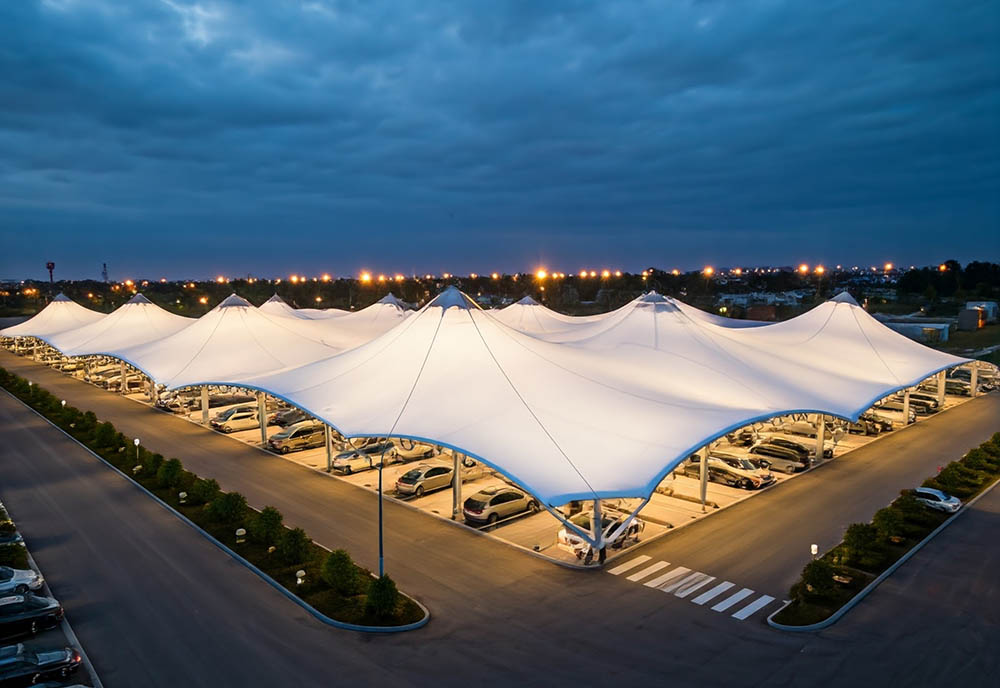Modern architecture is constantly evolving, and so are the materials behind it. One standout innovation is the PVC tension membrane structure fabric, widely used in stadiums, canopies, walkways, and pavilions. These lightweight yet highly durable materials not only shape eye-catching structures but also provide practical performance under extreme weather conditions.
In this article, we focus on PVC architectural membrane—one of the most popular types of membrane fabric—and why it’s a trusted choice for both form and function.
What Is PVC Tension Membrane Structure Fabric?

PVC tension membrane structure fabric is a specialized textile material designed to carry tensile loads when stretched across a structural frame. Rather than relying on compression or bending resistance, it gains strength and stability through tension. This allows for the creation of expansive, fluid architectural designs that are lightweight and visually distinctive.
In most commercial applications, PVC (polyvinyl chloride)-coated polyester fabric is used due to its excellent balance of strength, flexibility, and cost-effectiveness. This material is engineered to withstand environmental stressors while offering design freedom not easily achievable with traditional construction materials.
Features of PVC Architectural Membrane
PVC architectural membrane is a multi-layer composite fabric with specific coatings and treatments that enhance performance. It typically consists of three key layers: the base fabric (usually polyester), a PVC coating, and a top surface treatment.
Here are the major features buyers should know:
Waterproof and UV Resistant: Designed to endure heavy rain and constant sunlight without degrading.
Flame-Resistant: Meets international fire safety standards, making it suitable for public spaces.
Self-Cleaning and Dirt Resistant: Top coatings offer hydrophobic and anti-stick properties, reducing maintenance needs.
Abrasion and Scratch Resistant: Built to withstand mechanical wear, especially in high-traffic or exposed environments.
Temperature Resistant: Remains flexible in low temperatures (-30°C) and stable in heat (+70°C).
Anti-Microbial and Enzyme Resistant: Prevents mold growth, which is crucial in humid regions.
These features make PVC membrane fabrics particularly appealing for both temporary and permanent architectural applications.
Why Dimensional Stability and Tear Strength Matter
When it comes to large-scale PVC tension membrane structures, mechanical performance is non-negotiable.
Two factors stand out:
1. Dimensional Stability ensures that the fabric holds its shape under stress and thermal expansion. This helps maintain the intended form and tension of the structure over time.
2. Tear Strength is critical to resisting ripping or propagation of small cuts, especially at tension points or near fixtures and fasteners.
These two properties, combined with strong adhesion between the base fabric and the PVC coating, make the material reliable even under dynamic loads such as wind and snow.
Is PVC Membrane Suitable for Your Project?
PVC tension membrane structure fabric is a smart choice for a wide range of architectural uses, including:
Sports stadiums and arenas
Airport terminals and hangars
Pedestrian canopies and walkways
Exhibition tents and event structures
Public transport shelters
Its lightweight nature reduces the need for heavy substructures, saving on cost and construction time. The reflective or glossy finishes also enhance aesthetic appeal—an important factor for visually iconic buildings. If your project demands flexibility, durability, and visual impact, PVC membrane is worth serious consideration.
How to Properly Maintain PVC Membrane Fabric
While PVC membrane fabrics are engineered for longevity, proper care extends their life and keeps them looking clean and professional.
Follow these simple maintenance guidelines:
Avoid Surface Damage: Prevent scratches and mechanical wear during transport or installation.
Store Properly: Keep rolls in a clean, dry, and temperature-stable area to prevent degradation.
Gentle Cleaning Only: Do not use solvent-based cleaners like alcohol or acetone, nor strong alkaline detergents.
Routine Dust Cleaning: Use cold or warm water to rinse off dirt, then dry with a soft cloth or air blower.
Organic Stain Removal: For bird droppings or similar contaminants, rinse with water or apply neutral detergent before wiping.
Adhering to these care tips will help maintain the material’s performance and appearance over time, especially in exposed outdoor settings.
PVC tension membrane structure fabrics offer a compelling blend of aesthetics, structural performance, and long-term value. Their weather resistance, flame-retardant properties, and low-maintenance surfaces make them ideal for a wide range of architectural applications. Understanding their features and how to maintain them helps ensure lasting success in any design project.






























